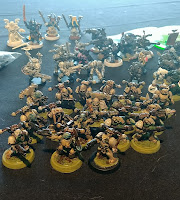Running a day late. Sorry about that.
So, I kinda wanted to revisit an idea I’ve talked about once or thrice. But I’m going to come at it from a new angle, so don’t worry—you might still get something out of it.
I’m guessing four out of five of you reading this probably dabble in what often gets called “
genre fiction.”
It’s when we can slap a quick, easy label on a manuscript.
Sci-fi.
Fantasy.
Romance. Horror.
And there’s sub-genres and sub-sub genres and the labels can just get more and more specific.
I’m also sure everybody here wants to write the best stuff they can.
I hope you do, anyway. The coolest sci-fi, the most heart-warming romance, the creepiest,
gnaw-at-your-mind horror.
That’s the goal, right?
When I started telling longer stories, it was my goal. I tried to make everything cool. I tried to have all those moments that made people gasp with excitement and terror. I tried to make my story like the other stories I’d seen that did these things.
But I had a couple of invisible issues, so to speak. Problems I didn’t even know I was dealing with. And a lot of them burned down to experience.
Firstoff… well, I was really new at this.
In every sense.
Some of you may remember me saying that I got my first rejection when I was eleven.
And at that point about
90% of my intake was comic books and old
Doctor Who episodes, with the occasional
Star Wars novel here or there.
And, in the big scheme of things, I hadn’t even read a lot of those.
So a lot of the stuff I thought was bold and clever was actually cliché, well used tropes.
It was just that I’d never seen them before.
For example, one of my favorite comics as a kid was
ROM. But it wasn’t until much later that I realized
ROM was pretty much just Bill Mantlo doing his own version of
The Invaders, which was really Larry Cohen doing his own version of
Invasion of the Body Snatchers, which was Hollywood
doing their own version of the storyfrom same-named novel.
And there’s nothing wrong with any of that… except my assumption that the elements in
ROMwere completely new and never seen before.
Secondwas me trying to do all this cool stuff in my own writing.
There wasn’t anything wrong with the individual ideas, just that I was trying to do them at my clumsy, inexperienced level.
Trying to be cool.
Trying to be scary.
For example, again, y’know that bit in
every other horror movie when something bursts out from around the corner or behind the curtain, and it just turns out to be a cat or Wakko playing a stupid prank?
We generally call that a cheap shot.
Cheap shots aren’t scary—they’re the storyteller
trying to be scary.
It’s me ignoring whatever’s going on in the actual story to toss a cat in your lap.
Another one that comes up a lot—especially in films—is nudity
Some people think throwing in random nudity is hot or sexy.
But just as often it can be creepy, demeaning, or just… weird
When we toss in random, unconnected elements like this, we’re doing it to try and create an effect, not for the sake of the story itself. It doesn’t matter how the cat got there or why it decided to leap randomly out after sitting quietly or why Phoebe decided walking through a cobweb meant she should take her shirt off while she was exploring the cellar. It’s all just a storyteller trying to get a reaction, and how they get it is kind of irrelevant. The ends justifying the means, as some folks might say.
Which is, in my mind, kinda crappy storytelling.
Some of you know that I like
watching bad movies on the weekend and live-tweeting big (often easily-avoidable) story problems that come up.
A while back I watched one, a horror movie, which had
tons of scary elements in it.
Tons of them.
The problem was, it was just tons of scary elements from other stories and movies, all just crammed in an attempt to make things scary without any thought to the characters, the scene, or the story as a whole.
It almost felt like horror movie mad libs, where the filmmakers just said “Okay, we need a scary thing.
And another scary thing.
And another scary thing.
And…”
There’s two issues with doing this.
One kinda connects to this “trying” aspect and the other is its own thing –I’ll get to it in a moment.
The other one is something I’ve talked about before.
I can’t take something that’s funny/cool/scary/sexy in another story, shove it into mine, and expect it’s
automatically going to get the same effect.
Especially when the elements on either side of it are also random things from other sources.
An element can be really disturbing in your story but absurdly funny in mine.
There are tons of YouTube videos that prove this point—splicing together two elements from different films and creating an entirely new, different effect.
And this brings us to the other aspect of the “many scary things” problem, which is also the third overall issue when I start cramming stuff into my story. It’s also another one that I’ve mentioned a couple times before. A bunch of story points is not the same thing as a story. I can have a hundred cool fantasy elements in my manuscript, but that doesn’t mean I’ve told a cool fantasy story. A few dozen sexy, romantic moments don’t mean I’ve written a good romance. And the biggest pile of cheap shots and scary beats don’t add up to a solid horror story.
When I just start
cramming these things in, I’m breaking up whatever coherent story I might actually have.
It’s becoming that random bunch of story points that don’t add up to anything.
I need to be adding things that
serve a purpose within the story, not just in what I want the story to do in some vague, overall way.
I want things to be sexy and romantic, sure, but in service to the story, not just to be five seconds of sexy or thirty seconds of romance.
This is a tough thing to grasp, I know. How can trying to put more action in an action story not be a good thing? How can more scary things in a horror story not be good? But this is one of those little, subtle lessons that lets us go from being adequate writers to really good writers. Some folks like to fall back on “the end justifies the means,” but this ignores the fact that whatever means I use are going to determine the kind of ending I actually get. And if my means are just random, haphazard elements…
Well, what kind of end will that give me?
Do I want something that’s trying to be a cool sci-fi novel? Or do I just want to write a cool sci-fi novel? Y’see, Timmy, I can incorporate almost anything and everything I want into my story. But I need to actually incorporate it and not leave it sitting alongside. Because I don’t want a pile of elements—I want a pyramid. A perfect structure that’ll awe people for ages after they’ve seen it.
Anyway…
Here’s a quick reminder that my new book, Dead Moon, is out exclusively from Audible in just two weeks time. Believe me when I say there will be more reminders in the weeks to come.
Next time, I think I’d like to expand on something I touched on here today…
Until then, go write…









